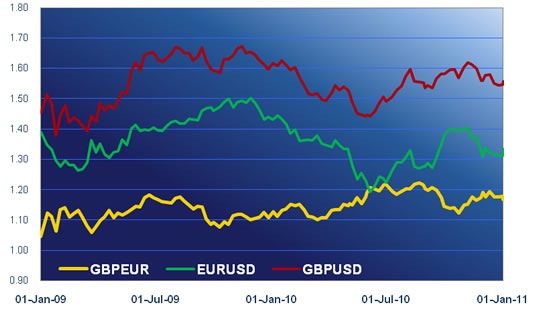– Mixed reaction by sterling
– UK employment data today
Good morning. Inflation is not just a financial phenomenon. The exhortation from the health industry used to be “five a day”; five portions of fresh vegetables and fruit to reduce the risk of heart disease. Yesterday they upped the ante. A new study will recommend “at least eight daily servings of fresh food”. And they are not talking about Beaujolais nouveau. The increase from five to eight implies on its own a 60% increase in the fruit and veg shopping bill. Tack onto that the overall rise in prices and we are suddenly spending 60.6% more on carrots and kumquats than a year ago. All this in a time of austerity. Today’s papers draw attention to an explosion in the number of people who sneak out of restaurants without paying the bill; perhaps farmers should now be considering heightened security around their carrot fields.
The financial aspect of inflation was not as massive as the dietary shift yesterday but it was still way above most analysts’ forecasts. The harmonised consumer price index (CPI) went up by 3.7% in 2010 while the retail price index, a measure that more accurately reflects the real cost of living, rose by 4.8%. Inflation has come a long way in short time. The retail price index (RPI) went down by -1.6% in the year to June 2009; a year later it was up to +5.0%. Inflation has accelerated by an average of about a third of a percentage point a month over the last 18 months. Were it to carry on at that speed we would be looking at an RPI inflation rate of 9% for calendar 2011.
It will not happen, of course, but it is the fear of that outcome that is driving the calls for higher interest rates today. Prices are rising more quickly than wages, as we will see this morning, and real interest rates are a negative -4.3% (Bank Rate minus RPI inflation; not a scientifically precise calculation but near enough to be a guide)*. Surveys continue to show that the general public has little faith in the Bank of England’s 2% target for CPI inflation. The risk is that pricing decisions and wage negotiations will be informed by the assumption of an even higher inflation rate, becoming a self-fulfilling prophesy. On the other side of the argument, a long line of economists and businesspeople stands ready to list the reasons why the Bank should stick to its guns and hold interest rates steady. Essentially, they worry that the psychological effect of a rate increase now would be to make consumers and businesses more nervous about their future, making them even more reluctant to spend the money upon which the recovery depends.
The ebb and flow of that debate was clear on Tuesday morning when the inflation statistics came out. The initial reaction among investors was to buy the pound: Higher inflation increases the chance of higher interest rates, making the currency more attractive. Then the opposition arguments came into play: 1) Higher interest rates would choke off the recovery; 2) If the Bank of England holds rates steady it will be abdicating its responsibilities for inflation and that would be a bad thing for sterling. Both sides of the debate are persuasive.
As for the remainder of Wednesday’s ecostats, ZEW’s surveys of economic confidence in Germany and the EU showed improvements all round. Coming out half an hour after the UK inflation report the numbers put a cap on sterling’s progress against the euro. In the States the New York Fed’s manufacturing index improved by two points to 11.9, the Treasury’s TIC report showed a near-tripling of capital inflows in November and the NAHB housing market index continued to bump along the bottom at an unchanged 16 (out of a hundred). The Canadian dollar fell after the Bank of Canada’s announcement that its policy interest rate would stay at 1.0% for a fifth month.
Today’s ecostat crop includes little from Euroland; just November’s current account and construction output. The US delivers December’s housing starts and building permits and Canada reveals November’s manufacturing shipments.
So for a second day the main event will be the UK figures, this time those for employment. The most important figure from the market’s point of view will be the change in jobless claims. A month ago claims went down by a measly -1,200 but at least they did go down. Investors will also be keen to see whether public sector lay-offs are being matched by private sector hirings. The chancellor said they would be but, to date, there has been no evidence of it happening.
The situation with today’s UK employment data is almost an exact opposite to yesterday’s inflation numbers. Weaker than expected employment figures will be bad for the pound; strong figures are almost impossible to imagine.
* By way of comparison, inflation in South Africa for calendar 2010 is expected to come out at 3.6% today and the South African Reserve Bank will probably leaved its policy interest rate at 5.5% tomorrow. The resulting positive real interest rate of +1.9% is one of the reasons behind the rand’s steady appreciation against sterling over the year.






